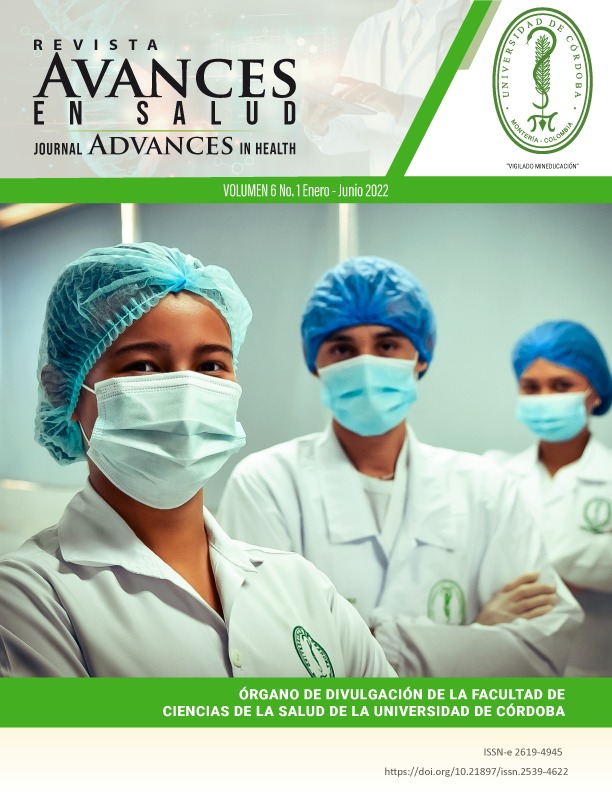Síndrome Poliglandular Autoinmune: Revisión de una condición clínica subestimada
POLYGLANDULAR AUTOIMMUNE SYNDROME EPIDEMIOLOGICAL REVIEW OF AN UNDERESTIMATED CLINICAL CONDITION

Esta obra está bajo una licencia internacional Creative Commons Atribución-CompartirIgual 4.0.
Mostrar biografía de los autores
Objetivo: Revisión al respecto del síndrome poli glandular autoinmune desde el punto de vista epidemiológico y clínico terapeutico. Materiales y Métodos: Se realizó una búsqueda detallada en la literatura científica durante los últimos 30 años sobre los términos Enfermedades Autoinmunes, Endocrinología, Genética, Asesoramiento Genético, síndrome poliglandular autoinmune a través de los motores de pubmed. Se seleccionaron las 50 referencias con mayor impacto en idioma ingles Resultados: Los síndromes autoinmunes poli glandulares son enfermedades multifactoriales con al menos dos endocrinopatías mediadas por autoinmunidad coexistentes. En la mayoría de las endocrinopatías el proceso autoinmune provoca una pérdida irreversible de la función glandular. El juvenil o tipo I se hereda de manera monogenética, mientras que ocurren varios polimorfismos de genes de susceptibilidad para los pacientes adultos. Ello es relevante para un diagnóstico oportuno en una etapa temprana es la detección de autoinmunidad poli glandular en pacientes con enfermedad autoinmune monoglandular y/o familiares de primer grado de pacientes con síndrome poli glandular autoinmune. En adultos la forma más prevalente es la combinación de diabetes tipo 1 con enfermedad tiroidea autoinmune. Conclusiones: Se recomienda la detección temprana de auto anticuerpos específicos y disfunción latente específica de órganos para alertar a quienes manejan este tipo de pacientes así como el asesoramiento genético oportuno.
Visitas del artículo 268 | Visitas PDF
Descargas
- Kahaly GJ. Polyglandular autoimmune syndromes. Eur J Endocrinol [Internet]. 2009;161(1):11–20. Disponible en: http://dx.doi.org/10.1530/eje-09-0044
- Eisenbarth GS, Gottlieb PA. Autoimmune polyendocrine syndromes. N Engl J Med [Internet]. 2004;350(20):2068–79. Disponible en: http://dx.doi.org/10.1056/NEJMra030158
- Cutolo M. Autoimmune polyendocrine syndromes. Autoimmun Rev. 2014 Feb;13(2):85-9. doi: 10.1016/j.autrev.2013.07.006.
- Martinez Lopez MM, González Casado I, Alvarez Doforno R, Delgado Cerviño E, Gracia Bouthelier R. Mutacion del gen AIRE en el síndrome poliglandular tipo I [AIRE gene mutation in polyglandular syndrome type 1]. An Pediatr (Barc). 2006 Jun;64(6):583-7. Spanish. doi: 10.1157/13089925.
- Hansen MP, Kahaly GJ. Autoimmune polyglandular syndromes. Deutsche medizinische Wochenschrift [Internet]. 2013;138(7):327–318. Disponible en: http://dx.doi.org/10.1055/s-0032-1327355
- Forster G, Krummenauer F, Kuhn I, Beyer J, Kahaly G (1999) Polyglandular autoimmune syndrome type II: epidemiology and forms of manifestation. Dtsch Med Wochenschr 124(49):1476– 1481. doi:10.1055/s-2008-1035684
- Hansen MP, Matheis N, Kahaly GJ. Type 1 diabetes and polyglandular autoimmune syndrome: A review. World J Diabetes. 2015 Feb 15;6(1):67-79. doi: 10.4239/wjd.v6.i1.67.
- Kahaly GJ, Frommer L. Polyglandular autoimmune syndromes. J Endocrinol Invest. 2018 Jan;41(1):91-98. doi: 10.1007/s40618-017-0740-9.
- Sperling MA, Angelousi A, Yau M. Autoimmune Polyglandular Syndromes. 2021 Apr 10. In: Feingold KR, Anawalt B, Boyce A, Chrousos G, de Herder WW, Dhatariya K, Dungan K, Hershman JM, Hofland J, Kalra S, Kaltsas G, Koch C, Kopp P, Korbonits M, Kovacs CS, Kuohung W, Laferrère B, Levy M, McGee EA, McLachlan R, Morley JE, New M, Purnell J, Sahay R, Singer F, Sperling MA, Stratakis CA, Trence DL, Wilson DP, editors. Endotext [Internet]. South Dartmouth (MA): MDText.com, Inc.; 2000–. PMID: 25905375.
- Ruggeri RM, Giuffrida G, Campennì A. Autoimmune endocrine diseases. Minerva Endocrinol. 2018 Sep;43(3):305-322. doi: 10.23736/S0391-1977.17.02757-2.
- 11. Betterle C, Zanchetta R. The immunofluorescence techniques in the diagnosis of endocrine autoimmune diseases. Auto Immun Highlights. 2012 Jun 6;3(2):67-78. doi: 10.1007/s13317-012-0034-3.
- Arlt W, Allolio B. Adrenal insufficiency. Lancet. 2003 May 31;361(9372):1881-93. doi: 10.1016/S0140-6736(03)13492-7.
- Husebye ES, Perheentupa J, Rautemaa R, Kämpe O. Clinical manifestations and management of patients with autoimmune polyendocrine syndrome type I. J Intern Med. 2009 May;265(5):514-29. doi: 10.1111/j.1365-2796.2009.02090.x.
- Bensing S, Brandt L, Tabaroj F, Sjöberg O, Nilsson B, Ekbom A, Blomqvist P, Kämpe O. Increased death risk and altered cancer incidence pattern in patients with isolated or combined autoimmune primary adrenocortical insufficiency. Clin Endocrinol (Oxf). 2008 Nov;69(5):697-704. doi: 10.1111/j.1365-2265.2008.03340.x.
-
- Dittmar M, Kahaly GJ. Polyglandular autoimmune syndromes: immunogenetics and long-term follow-up. J Clin Endocrinol Metab. 2003 Jul;88(7):2983-92. doi: 10.1210/jc.2002-021845.
- Mourinho Bala N, Gonçalves RS, Serra Caetano J, Cardoso R, Dinis I, Mirante A. Autoimmune Primary Adrenal Insufficiency in Children. J Clin Res Pediatr Endocrinol. 2022 Aug 25;14(3):308-312. doi: 10.4274/jcrpe.galenos.2022.2021-11-9.
-
- Horie I, Kawasaki E, Ando T, Kuwahara H, Abiru N, Usa T, Yamasaki H, Ejima E, Kawakami A. Clinical and genetic characteristics of autoimmune polyglandular syndrome type 3 variant in the Japanese population. J Clin Endocrinol Metab. 2012 Jun;97(6):E1043-50. doi: 10.1210/jc.2011-3109.
- 18. Yoshioka K, Ohsawa A, Yoshida T, Yokoh S. Insulin-dependent diabetes mellitus associated with Graves' disease and idiopathic hypoparathyroidism. J Endocrinol Invest. 1993 Sep;16(8):643-6. doi: 10.1007/BF03347687.
- Lupi I, Raffaelli V, Di Cianni G, Caturegli P, Manetti L, Ciccarone AM, et al. Pituitary autoimmunity in patients with diabetes mellitus and other endocrine disorders. J Endocrinol Invest [Internet]. 2013;36(2):127–31. Disponible en: http://dx.doi.org/10.1007/BF03346747
- Kisand K, Peterson P. Autoimmune polyendocrinopathy candidiasis ectodermal dystrophy. J Clin Immunol. 2015 Jul;35(5):463-78. doi: 10.1007/s10875-015-0176-y.
- 21. Myhre AG, Halonen M, Eskelin P, Ekwall O, Hedstrand H, Rorsman F, et al. Autoimmune polyendocrine syndrome type 1 (APS I) in Norway. Clin Endocrinol (Oxf) [Internet]. 2001;54(2):211–7. Disponible en: http://dx.doi.org/10.1046/j.1365-2265.2001.01201.x
- Sato K, Nakajima K, Imamura H, Deguchi T, Horinouchi S, Yamazaki K, Yamada E, Kanaji Y, Takano K. A novel missense mutation of AIRE gene in a patient with autoimmune polyendocrinopathy, candidiasis and ectodermal dystrophy (APECED), accompanied with progressive muscular atrophy: case report and review of the literature in Japan. Endocr J. 2002 Dec;49(6):625-33. doi: 10.1507/endocrj.49.625.
- 23. Dominguez M, Crushell E, Ilmarinen T, McGovern E, Collins S, Chang B, Fleming P, Irvine AD, Brosnahan D, Ulmanen I, Murphy N, Costigan C. Autoimmune polyendocrinopathy-candidiasis-ectodermal dystrophy (APECED) in the Irish population. J Pediatr Endocrinol Metab. 2006 Nov;19(11):1343-52. doi: 10.1515/jpem.2006.19.11.1343.
- Betterle C, Dal Pra C, Mantero F, Zanchetta R. Autoimmune adrenal insufficiency and autoimmune polyendocrine syndromes: autoantibodies, autoantigens, and their applicability in diagnosis and disease prediction. Endocr Rev. 2002 Jun;23(3):327-64. doi: 10.1210/edrv.23.3.0466.
- 25. Betterle C, Lazzarotto F, Presotto F. Autoimmune polyglandular syndrome Type 2: the tip of an iceberg? Clin Exp Immunol. 2004 Aug;137(2):225-33. doi: 10.1111/j.1365-2249.2004.02561.x.
-
- Dittmar M, Kahaly GJ. Polyglandular autoimmune syndromes: immunogenetics and long-term follow-up. J Clin Endocrinol Metab. 2003 Jul;88(7):2983-92. doi: 10.1210/jc.2002-021845.
- Waterfield M, Anderson MS. Clues to immune tolerance: the monogenic autoimmune syndromes. Ann N Y Acad Sci. 2010 Dec;1214:138-55. doi: 10.1111/j.1749-6632.2010.05818.x.
- Wolff AS, Erichsen MM, Meager A, Magitta NF, Myhre AG, Bollerslev J, Fougner KJ, Lima K, Knappskog PM, Husebye ES. Autoimmune polyendocrine syndrome type 1 in Norway: phenotypic variation, autoantibodies, and novel mutations in the autoimmune regulator gene. J Clin Endocrinol Metab. 2007 Feb;92(2):595-603. doi: 10.1210/jc.2006-1873.
- 29. Chan AY, Anderson MS. Central tolerance to self revealed by the autoimmune regulator. Ann N Y Acad Sci. 2015 Nov;1356(1):80-9. doi: 10.1111/nyas.12960.
- 30. Halonen M, Eskelin P, Myhre AG, Perheentupa J, Husebye ES, Kämpe O, Rorsman F, Peltonen L, Ulmanen I, Partanen J. AIRE mutations and human leukocyte antigen genotypes as determinants of the autoimmune polyendocrinopathy-candidiasis-ectodermal dystrophy phenotype. J Clin Endocrinol Metab. 2002 Jun;87(6):2568-74. doi: 10.1210/jcem.87.6.8564.
- 31. Meloni A, Willcox N, Meager A, Atzeni M, Wolff AS, Husebye ES, Furcas M, Rosatelli MC, Cao A, Congia M. Autoimmune polyendocrine syndrome type 1: an extensive longitudinal study in Sardinian patients. J Clin Endocrinol Metab. 2012 Apr;97(4):1114-24. doi: 10.1210/jc.2011-2461. Epub 2012 Feb 16. PMID: 22344197.
- 32. Barkia Beradhi S, Flesch BK, Hansen MP, Matheis N, Kahaly GJ. HLA Class II Differentiates Between Thyroid and Polyglandular Autoimmunity. Horm Metab Res. 2016 Apr;48(4):232-7. doi: 10.1055/s-0035-1559622.
- Flesch BK, Matheis N, Alt T, Weinstock C, Bux J, Kahaly GJ. HLA class II haplotypes diferentiate between the adult autoimmune polyglandular syndrome types II and III. J Clin Endocrinol Metab [Internet]. 2014;99(1):E177–82. Disponible en: http://dx.doi.org/10.1210/jc.2013-2852
- Bellone M (2001) Autoimmune disease: pathogenesis. In: eLS. Wiley. doi:10.1038/npg.els.0004000
- Kang S-Y, Oh J-H, Song SK, Lee JS, Choi JC, Kang J-H. Both binding and blocking antibodies correlate with disease severity in myasthenia gravis. Neurological Sciences. 2015 May 12;36(7):1167–71.
- 36. Ortega SB, Noorbhai I, Poinsatte K, Kong X, Anderson A, Monson NL, et al. Stroke induces a rapid adaptive autoimmune response to novel neuronal antigens. Discov Med. 2015;19(106):381–92.
- Ramos-Lopez E, Lange B, Kahles H, Willenberg HS, Meyer G, Penna-Martinez M, et al. Insulin gene polymorphisms in type 1 diabetes, Addison’s disease and the polyglandular autoimmune syndrome type II. BMC Med Genet [Internet]. 2008;9(1):65. Disponible en: http://dx.doi.org/10.1186/1471-2350-9-65
- Huang W, Connor E, Rosa TD, Muir A, Schatz D, Silverstein J, et al. Although DR3-DQB1*0201 may be associated with multiple component diseases of the autoimmune polyglandular syndromes, the human leukocyte antigen DR4-DQB1*0302 haplotype is implicated only in beta-cell autoimmunity. J Clin Endocrinol Metab [Internet]. 1996;81(7):2559–63. Disponible en: http://dx.doi.org/10.1210/jcem.81.7.8675578
- Maclaren Nk, Riley Wj. Inherited Susceptibility to Autoimmune Addison’s Disease Is Linked to Juman Leukocyte Antigens-DR3 and/or DR4, except when Associated with Type I Autoimmune Poluglandular Syndrome*. The Journal of Clinical Endocrinology & Metabolism. 1996 Mar;62(3):455–9.
- Robles DT, Fain PR, Gottlieb PA, Eisenbarth GS. The genetics of autoimmune polyendocrine syndrome type II. Endocrinol Metab Clin North Am [Internet]. 2002;31(2):353–68, vi–vii. Disponible en: http://dx.doi.org/10.1016/s0889-8529(01)00015-9
- Dittmar M, Kahaly GJ. Genetics of the Autoimmune Polyglandular Syndrome Type 3 Variant. Thyroid. 2010 Jul;20(7):737–43.
- 42. Bello MO, Garla VV. Polyglandular Autoimmune Syndrome Type I. 2021 Jul 21. In: StatPearls [Internet]. Treasure Island (FL): StatPearls Publishing; 2022 Jan.
- Zlotogora J, Shapiro MS. Polyglandular autoimmune syndrome type I among Iranian Jews. Journal of Medical Genetics. 1992 Nov 1;29(11):824–6.
- Ahonen P, Myllärniemi S, Sipilä I, Perheentupa J. Clinical variation of autoimmune polyendocrinopathy-candidiasis-ectodermal dystrophy (APECED) in a series of 68 patients. N Engl J Med [Internet]. 1990;322(26):1829–36. Disponible en: http://dx.doi.org/10.1056/NEJM199006283222601
-
- Bartalena L, Chiovato L, Vitti P. Management of hyperthyroidism due to Graves’ disease: frequently asked questions and answers (if any). Journal of Endocrinological Investigation. 2016 Jun 18;39(10):1105–14.
- 46. Bartalena L, Masiello E, Magri F, Veronesi G, Bianconi E, Zerbini F, et al. The phenotype of newly diagnosed Graves’ disease in Italy in recent years is milder than in the past: results of a large observational longitudinal study. Journal of Endocrinological Investigation. 2016 Jul 27;39(12):1445–51.
-
- Bartalena L, Veronesi G, Krassas GE, Wiersinga WM, Marcocci C, Marinò M, et al. Does early response to intravenous glucocorticoids predict the final outcome in patients with moderate-to-severe and active Graves’ orbitopathy? Journal of Endocrinological Investigation. 2017 Feb 7;40(5):547–53.
-
- Eenkhoorn V, Van den Driessche A, Van Gaal L, Desager K, De Block C. Diabetic keto-acidosis as a presentation of cystic fibrosis-related diabetes: a case report. Journal of Diabetes and its Complications. 2011 Mar;25(2):137–41.
-
- Iwashita A, Kobayashi I, Inukai T, Takahashi M, Ishii A, Ohshima K, et al. Influence of Thyrotropin-releasing Hormone on Autonomic Nervous System Determined by the Variations in R-R Interval on Electrocardiogram. Experimental and Clinical Endocrinology & Diabetes. 2009 Jul 16;96(04):121–4.
- Wallaschofski H, Meyer A, Tuschy U, Lohmann T. HLA-DQA1*0301-associated susceptibility for autoimmune polyglandular syndrome type II and III. Horm Metab Res [Internet]. 2003;35(2):120–4. Disponible en: http://dx.doi.org/10.1055/s-2003-39059.
- Bensing S , Fetissov SO , Mulder J , Perheentupa J , Gustafsson J , Husebye . ES , et al. Pituitary autoantibodies in autoimmune polyendocrine syndrome type 1 . Proc Natl Acad Sci USA . 2007 ; 104 : 949 - 54 .
- Betterle C , Dal Pra C , Mantero F , Zanchetta R . Autoimmune adrenal insufficiency and autoinmune polyendocrine sindromes: autoantibodies, autoantigens and their applicability in diagnosis and disease prediction . Endocr Rev . 2002 ; 23 : 327 - 64 .
- Dittmar M , Kahaly GJ . Polyglandular Autoimmune syndromes: immunogenetics and long-term follow-up . J Clin Endocrinol Metab . 2003 ; 88 : 2983 - 92.
- Kahaly GJ . Polyglandular autoimmune syndromes . Eur J Endocrinol . 2009 ; 161 : 11 - 20 .
- Meloni A , Furcas M , Cetani F , Marcocci C , Falorni A , Perniola R, et al. Autoantibodies against type I interferons as an additional diagnostic criterion for autoimmune polyendocrine síndrome type I . J Clin Endocrinol Metab . 2008 ; 93 : 4389 - 97
-








